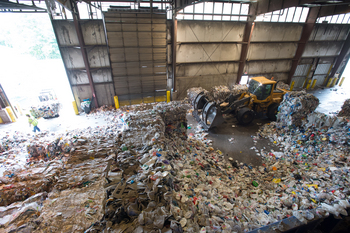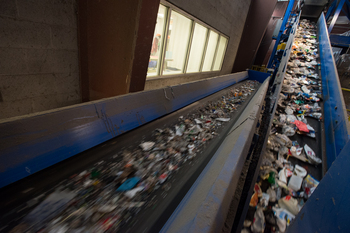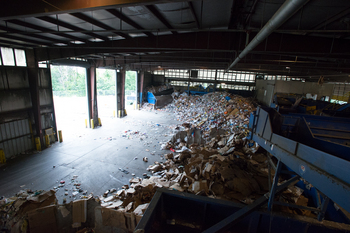Inside Ann Arbor's 20 ton-per-hour single-stream recycling center
VIDEO: A load of plastic material is sorted and compacted into bales at Ann Arbor's municipal Materials Recovery Facility from AnnArbor.com on Vimeo.
Courtney Sacco I AnnArbor.com
Through its single-stream recycling system, Ann Arbor recycled a total of 12,268 tons of material in 2012.
Every scrap of that 12,268 tons was processed through the city’s Materials Recovery Facility — or MRF, as it’s more affectionately called — at 4150 Platt Road in Ann Arbor.

A front end loader moves unsorted recyclables Friday, July 5 as they are delivered to Ann Arbor's municipal Materials Recovery Facility.
Courtney Sacco I AnnArbor.com
Collected curbside from area homes and businesses by Recycle Ann Arbor staff in tall blue bins, every wad of paper, empty yogurt cup and unneeded water bottle ends up in the same place: on the warehouse floor of the MRF.
From the floor, where the material is pushed around into giant piles, it is scooped onto a conveyer belt where it will be sorted both by hand and by machine.
First, bulky scrap metal and plastics are pulled out by hand. Plastic bags, which clog up the sorting machines, are also removed.
Next, mechanical sorters take their pick of the material still on the belt. Corrugated cardboard is whisked away, and then glass is shattered to fall onto another belt.
A magnet plucks off steel cans, while an optical scanning machine sorts out plastic materials based on their chemical composition.
At the end of the process, a reverse magnet sorts out the aluminum products.

Conveyor belts carry unsorted recyclable materials Friday, July 5 through Ann Arbor's municipal Materials Recovery Facility.
Courtney Sacco I AnnArbor.com
About 20 tons of recyclable material is processed through the facility in an hour. One shift of employees staffs the facility five days a week.
By ton, the MRF processes more paper than anything else — about 8,260 tons from the city of Ann Arbor in 2012. However, newspaper has the lowest value at $40 per ton.
Aluminum, which has the highest value at $1,000 per ton, saw the lowest volumes in 2012 at 22 tons.
In addition to processing the city’s single-stream recycling, ReCommunity contracts with a number of other communities, companies and organizations to process their material.
The University of Michigan, Eastern Michigan University and Washtenaw Community College consistently contract with ReCommunity for their recycling, said Nancy Stone, a communications liaison for the city of Ann Arbor's public service department.

Unsorted recyclables at Ann Arbor's municipal Materials Recovery Facility Friday, July 5.
Courtney Sacco I AnnArbor.com
The MRF has been managed by a private company since it opened in 1995, Stone said.
The private ownership means contracts can be negotiated and approved in a swifter, more businesslike fashion than with a municipal contract, Stone said.
ReCommunity has also developed a company to turn glass bottles into tiles and countertops, Stone said — a vital contract to have as the market for recycled glass bottles continues to shrink.
Glass bottles melt at a different temperature than windowpanes or car windshields. Many municipalities have stopped recycling glass bottles because it's not economically feasible, Stone said.
That's the same reason the city's single-stream recycling system doesn't accept plastic bags: Their market price is too low and they often are caught in the gears of the sorting machines, Stone said.
Stone said she hopes the list of materials the city is able to accept will soon be extended to carpet.
Recycle Ann Arbor announced this month that they will now be accepting mattresses and securely shredding hard drives at both their Drop-Off Station at 2950 E. Ellsworth Rd. in Ann Arbor and at their facility at 7891 Jackson Road.
Both facilities accept materials that can be recycled but are not accepted through the city's single-stream recycling pick-up.
Click on the markers in the map below to see where Ann Arbor's recyclables end up.
View Single-stream recycling markets for materials from Ann Arbor's MRF in a larger map
Amy Biolchini covers Washtenaw County, health and environmental issues for AnnArbor.com. Reach her at (734) 623-2552, amybiolchini@annarbor.com or on Twitter.


Comments
LilElvis
Sun, Jul 14, 2013 : 12:07 a.m.
As a new resident to Ann Arbor, I was surprised at the restrictions placed on your "single stream". I moved here from Battle Creek, where virtually any plastic was accepted and recycled, including plastic shopping bags, foam of all kinds including egg cartons and styro packaging. Ann Arbor is about 10 years behind the curve, and missing out on tons of otherwise recyclable materials going into our landfills. Welcome to the 21st century.
BhavanaJagat
Mon, Jul 8, 2013 : 4:32 p.m.
WholeDude - Whole Ecology: In the past, while working at Greenpeace, Ann Arbor, I was part of an effort to support Ecology Center in its campaign for recycling and recovery of reusable materials. It pains me when I find people dumping trash and garbage in the blue bins at apartment complexes. People are not paying attention to the information posted on the lids of these blue bins. I will not be surprised if they are collecting some trash for further disposal in a landfill. I wish that we openly acknowledge these problems and give a more precise account of our recovery efforts. We may have to find a cost-effective program to educate people as to the type and condition of items that could be deposited in the blue bins. When people place cardboard boxes, without concern to flatten them, the bin gets filled up easily and it excludes the opportunity of using the bin for recycling by others.
Ignatz
Mon, Jul 8, 2013 : 3:15 p.m.
I had a chance to tour this facility a bit ago. It's an amazing process; low tech industrial. The workers have it rough with the noise and heat, not to mention the cleanliness issues one can imagine. I was surprised to find out that they'd rather not have flat lids or caps to things such as bottles. The lids don't get sorted correctly due to their shape and the caps are often made of a different material from the bottles. They also take paper milk cartons that have the plastic spouts. They found a facility that can process those. Just remember to rinse.
LXIX
Mon, Jul 8, 2013 : 3:14 p.m.
Your Boss part II. "Subsequently, the Corporation brought suit against Mr. Bohlig for breach of the employment contract, alleging inappropriate self-dealing, breach of fiduciary responsibility, and breach of employment obligations arising from the contract. At trial, the Corporation maintained that Mr. Bohlig was dishonest to the Corporation in representing the scope of his home renovations and his ability to pay for the renovations. It claimed that he still owed a balance of $218,413.20 for the construction work. Mr. Bohlig counterclaimed for breach of the employment contract, maintaining that the amount he owed for construction work was offset by the amount the Corporation owed him in unpaid benefits under the employment contract. Specifically, he contended that the Corporation failed to pay him (1) a guaranteed bonus of $20,000 per year, (2) relocation expenses of $129,938.62, and (3) twelve months of severance pay and employment benefits in lieu of twelve months notice, amounting to over $110,000. "
LXIX
Mon, Jul 8, 2013 : 3:13 p.m.
Your Boss. Ann Arbor taxpayers are "working" to enrich for-profit company REcommunity. Recommunity was founded in North Carolina 4/2/2012 by Delaware parent corporation. James W. Bohlig of VT is the CEO co-founder. From public records- " In May 1989, Mr. Bohlig was hired as executive vice president and chief operating officer by the John A. Russell Corporation, a general contracting company in Rutland, Vermont. The parties entered into an employment contract for a term of three years on May 16, 1989. Shortly after starting his job, Mr. Bohlig began renovating his house in Shrewsbury using employees and equipment of the Corporation with the permission of the Corporation. The cost of the renovations eventually exceeded $600,000. At trial, the Corporation claimed it gave Mr. Bohlig notice in November 1991 that he was terminated effective December 31, 1991. Mr. Bohlig claimed he did not know of the termination until he returned to work in January 1992 and found his belongings had been removed from his office. The parties also disputed the reason for the termination."
Tom Whitaker
Mon, Jul 8, 2013 : 2:58 p.m.
"Through its single-stream recycling system, Ann Arbor recycled a total of 12,268 tons of material in 2012." Material is not "recycled" simply because it was sorted in the MRF. Recycling only occurs when the material is made into a new product. How many tons of material processed by the MRF actually ended up in the landfill, either because it was not a recyclable material, it was recyclable, but contaminated or there was no market for it? How does the current tonnage sent to the landfill compare to the tonnage when materials were pre-sorted by residents? Note that the collection rate cannot be equated with recycling rate unless you subtract the tonnage that goes straight from the MRF to the landfill. It should also be noted that although the private operator "shares a portion of its revenue with the City," the MRF was built and upgraded by City tax dollars. When the equipment needs repair or replacement, it will again by paid for by tax dollars. How about an investigative story on the costs of the MRF and all its upgrades (including the new carts and the subsidy of Recycle A2), versus the actual benefits to the City. I seem to recall some pretty rosy projections and some less than rosy initial results. Would the City have been better off financially with the previous two-stream system? Would the City be better off financially if it staffed the MRF and collection operations with City employees? Are we just socializing costs and privatizing profits?
RUKiddingMe
Mon, Jul 8, 2013 : 4:23 p.m.
A2.com, this seems like a great set of questions that would probably have interesting and informative answers. Overall, all costs/profits taken into account, which is working better? The new single stream or the old double? Which one resulted in more people recycling? In less cost to the city? Good stuff here for the intrepid reporter.
justcurious
Mon, Jul 8, 2013 : 2:29 p.m.
Great article. I hope those workers are paid well!! Not an easy job physically!
LXIX
Mon, Jul 8, 2013 : 2:24 p.m.
Recycling limited resources is survival for the next gens. Most people volunteer to recycle their goods. For a good reason. Common Sense. Humans will spend their own time/money to sustain a future. For-profit corporations will not. MRF is a for-profit corporation. "MRF... shares a portion of its revenues with the city". MRF processes 20 tons per hour with 2000 full time work hours per year = 40,000 tons processed per year Ann Arbor uses less than 1/3 of that capacity @ 12,238 tons Ann Arbor taxpayers built the entire facility that MRF and others use. Ami, EXACTLY how much "MRF...shares a portion of its revenues" do Ann Arbor taxpayers collect from their city facility investment and hard-worked recycled material? Does the shady-politics go-between RECYCLE ANN ARBOR tap any of this revenue? EXACTLY how much rent does MRF pay the city for using the Ann Arbor facility? What percent of the recycling profit of the remaining 2/3rd capacity users is being "shared" with the facility owner (A2 taxpayer)?
LXIX
Mon, Jul 8, 2013 : 3:40 p.m.
Haste makes waste (pun). My appologies. Your name is AMY. REcommunity is the name of the for-profit corporation running the MRF facility. EXACTLY how much does REcommunity pay the city for using the Ann Arbor MRF facility?
teeters
Mon, Jul 8, 2013 : 2 p.m.
Amy, do you have any numbers as to how much $ MRF makes in a year and how much is retured to the city and to the U? Does/could the city actually make a profit?
barefootdave
Mon, Jul 8, 2013 : 1:59 p.m.
"For profit private company." How long before weekly waste pickup is an additional charge to residents?
Dave66
Mon, Jul 8, 2013 : 1:13 p.m.
"At the end of the process, a reverse magnet sorts out the aluminum products." There's no such thing as a "reverse magnet." What are you going to make up next, reverse light?
EyeHeartA2
Mon, Jul 8, 2013 : 2:04 p.m.
http://en.wikipedia.org/wiki/Eddy_current_separator
Amy Biolchini
Mon, Jul 8, 2013 : 1:39 p.m.
The process was described to me as a "reverse magnet" -- meaning it's polarized to deflect the aluminum material away.
John of Saline
Mon, Jul 8, 2013 : 1:29 p.m.
It may be a term for a device that uses eddy currents to separate non-ferrous metal from other stuff. A colloquialism: http://en.wikipedia.org/wiki/Eddy_current_separator
EyeHeartA2
Mon, Jul 8, 2013 : 1:20 p.m.
I was wondering about that myself. We used to send newbies on a fool's errand to go get an aluminum magnet from the crib. Hmmmm.....How long has Amy been here anyway? Regarding the reverse light, I have some on my car and so do you, but I don't think that is what you meant.
John of Saline
Mon, Jul 8, 2013 : 1:12 p.m.
I'd be interested in knowing if a certain percentage of what is intended for recycling ends up landfilled anyway, for economic reasons.
John of Saline
Mon, Jul 8, 2013 : 1:11 p.m.
Waste Management (Saline trash/recycling contractor) takes plastic bags.
Amy Biolchini
Mon, Jul 8, 2013 : 1:38 p.m.
As do most grocery stores.
Carole
Mon, Jul 8, 2013 : 12:35 p.m.
Great article.
EyeHeartA2
Mon, Jul 8, 2013 : 12:28 p.m.
It costs $3 to get into the MRF. $10 for to "recycle" the hard drive and about $5 in gas to go back and forth. Total = $18 or so. Hitting it with a hammer and chucking it in the trash is free.
JimmyD
Mon, Jul 8, 2013 : 12:22 p.m.
Very nice article. Now that I know that some things (like plastic bags) don't get recycled I'll switch to something that does.
gee
Mon, Jul 8, 2013 : 12:07 p.m.
I didn't realize that plastic bags can't go through the process. Now I wonder what I can do with all of the plastic bags from frozen fruit & veggies, potstickers, etc.... I work hard to minimize these products, but haven't eliminated them altogether. I know some grocery stores will take used plastic grocery bags, but how about all of the "miscellaneous" ones?
Dos
Mon, Jul 8, 2013 : 9:58 p.m.
we use ours for poop bags when walking the dogs
A2comments
Mon, Jul 8, 2013 : 11:56 a.m.
Best Buy accepts most electronics for recycling. http://www.bestbuy.com/site/Global-Promotions/Recycling-Electronics/pcmcat149900050025.c?id=pcmcat149900050025
Linda Peck
Mon, Jul 8, 2013 : 11:51 a.m.
Very interesting, I have always wanted to know how this is done and it is amazing all this can be sorted in one shift, 5 days a week. It is good news about mattresses and hard drives being accepted this month, too. Thanks!
Susan Montgomery
Mon, Jul 8, 2013 : 11:45 a.m.
Cool map showing where everything ends up!